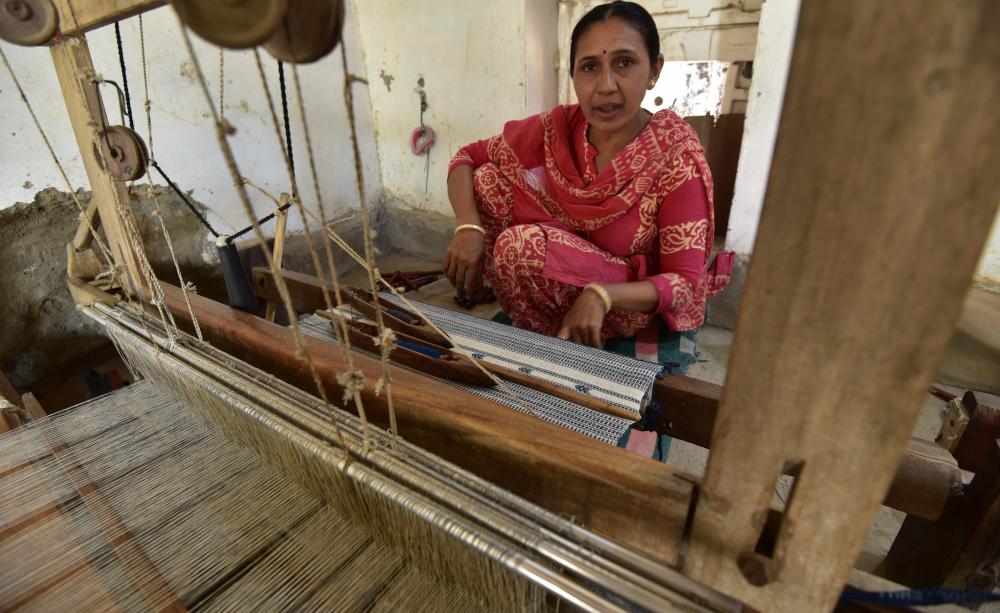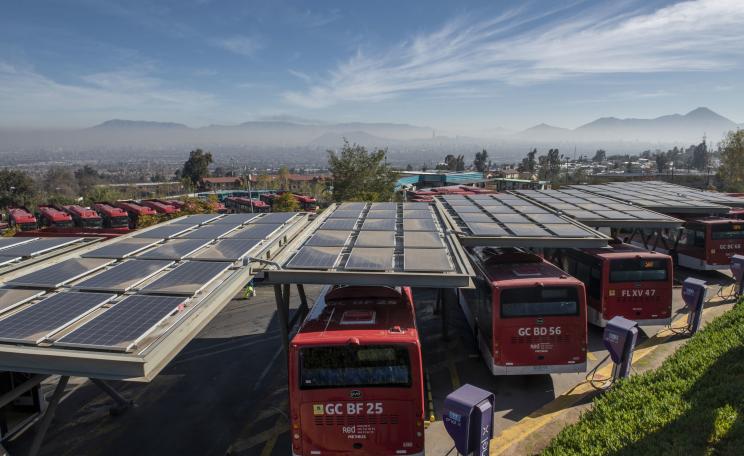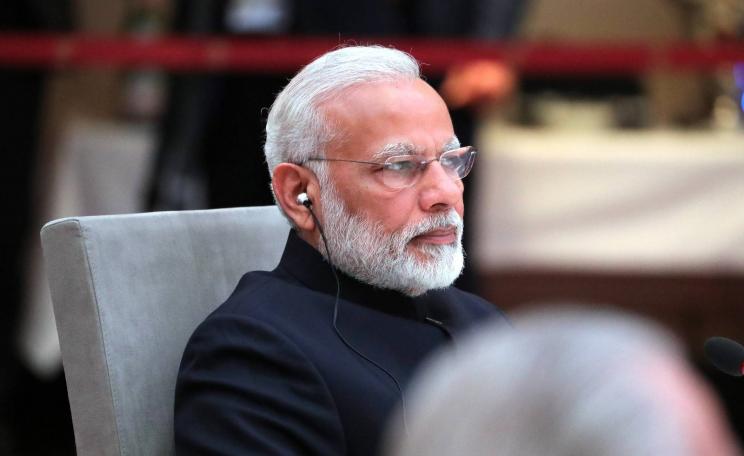-
Prakash Naranbhai Vankar looks up, taking a break from his intense concentration on the handloom he is weaving a carpet on.
I have just asked him why he has not gone into IT or some other ‘modern’ job that so many of his age have done. His response is the same mix of simplicity and complexity of the design he is weaving on his carpet: “My loom is my computer.”
I am with my colleagues from the civil society organisations Kalpavriksh and Khamir, and we are studying the transformations that handloom weavers and weaving have undergone here.
Constant thought
We are sitting in Prakash’s house, in Bhujodi village of the west Indian district of Kachchh, a vast region of grasslands and salt deserts and agro-pastoral ways of life that constitute one of India’s most unique biocultural landscapes.
In one of the many conversations that we were carrying out across the vankar (weaver) community, we are asking Prakash why he was continuing the family tradition of vanaat (weaving), instead of going into some industrial job or migrating to some middle-eastern country in search of more lucrative pastures.
Pressed to explain, he says that weaving carpets on a handloom is far from a mechanical job. There is constant thought, innovation, passion, satisfaction, and dedication going into it, as well as freedom, identity, and being with family.
Why would he want to be an anonymous labourer in someone else’s factory, or sit in an office subject to some boss’s command?
Our study is looking at the revival of a traditional craft in Kachchh, a phenomenon rarely seen elsewhere in India where, for decades, macro-economic policies have favoured mass machine production over handmade.
Mechanised labour
India’s famed textiles were once the largest and most diverse in the world, being exported to all parts of the world for at least the last 2000 years.
Th textile trade took a big hit during colonial times, when the British administration heavily taxed local production, imposed severe duties on imports of Indian textiles into Britain, squeezed out local yarns, and flooded Indian markets with products from its own mills.
After Independence, the industrialization and mechanization of the textile sector continued apace, despite Gandhi’s very sane advice to sustain and generate millions of livelihoods by maximizing hand production.
Powerlooms have replaced handlooms, yarn has become more expensive, wages for handloom workers have remained low. In most parts of the country, weavers are abandoning the craft, and the younger generation in particular no longer has the incentive to stay on.
But in Kachchh, handloom weaving has been on the rise in the last decade. So we have been looking at why this is the case, and what are its economic, social, cultural, and economic ramifications. Ours is part of a global study, the Activist-Academic Cogeneration of Knowledge for Environmental Justice (ACKnowl-EJ), sponsored by the International Science Council.
To understand the various dimensions of transformation, we are using a participatory analytical tool, the Alternatives Transformation Format. The tool has been developed by Kalpavriksh on the basis of learnings from Vikalp Sangam, a nation-wide process platform for alternative initiatives in various fields.
Revived traditions
Prakash is one of several youth who have either stayed back in vanaat. There are others who have, even more interestingly, come back to it after trying their hand at industrial, construction, and other jobs.
In Siracha village, over a dozen have quit (or were laid off from) working in the nearby Tata and Adani factories, and are back into weaving; another dozen or more are wanting to do the same. This is a village that had over 50 looms operational before a massive earthquake flattened Kachchh in 2001, destroying many traditional livelihoods.
Industries that came in quickly after that capitalized on the desperate need for work, snapping up the cheap labour of hundreds of people. From a total collapse of weaving around that time, Siracha is back to having about 20 looms, and looking forward to many more.
A host of factors has aided in this counter-trend. Perhaps the most important is the intervention of Khamir, an institution set up in the early 2000s to facilitate the sustenance of Kachchh’s unique crafts.
Khamir innovated on design and production, and revived the full ‘value chain’ linked to Kala cotton, an organically grown indigenous variety ideally suited to Kachchh’s aridity. It perfected the production of exquisite cloth and a range of products from Kala (carpets, shawls, saris, stoles, shirts, kurtas, bags), and helped find a niche market.
New handloom and design schools have also created opportunities for formal learning for young weavers, building on what they learn from their parents at home.
Hybrid culture
This ‘hybrid’ culture pervades the revival of vanaat. Young people are flowering into their own, expressing their creativity in ways their elders would not have imagined.
But they stay solidly faithful to the unique ‘Kachchhi chhaap’ motifs, still learn the basics of weaving at home, and continue to respect the wisdom and expertise of their parents. There are also technological hybrids; the fundamentals of the loom have remained the same, but marketing has found a new avenue in online platforms.
In Kotay village, young Shamjibhai told us: “I directly market my produce digitally; I can work from the comfort of my home while making a good living”.
Shamjibhai’s articulation displays one of the most interesting aspects of the revival. The renewed attraction of weaving for the youth most certainly has economic motivations, but this is explicitly mixed with socio-cultural ones.
In village after village we are told that being able to work at home, being with family (notably, traditionally as also now, weaving processes involve the entire family), continuing the craft heritage, having dignity in work, being one’s own time master, and being able to innovate using one’s own creativity, are also equal motivations.
Empowering women
Does this all comprise a quiet re-affirmation of Gandhi’s emphasis on the dignity of manual labour; and an escape from the all-too-common alienation from one’s own labour in capitalist production that Marx brilliantly exposed?
Of special significance is the taking up of vanaat by young women in many villages. While women have always been essential to the pre-loom processes (a part of vanaat being a family occupation, mentioned above), sitting on the loom has traditionally been almost exclusive domain of men. This is changing.
For both economic reasons as also simply because women are finding their voice and confidence, emerging from being subservient to men all these centuries, young girls to older women are now weaving, expressing their own creativity in the design and products, and even beginning to deal with the outside world in marketing and outreach.
Young Champa Siju Vankar of Awadhnagar weaves some of her own designs and recently exhibited her work in United Kingdom as part of an exchange programme.
In Jamthada village, in which over 20 girls have taken to weaving, several of them come for a meeting we’ve organised. Sheetal Hiteshbhai Sanjot said she earned Rs. 200 for 8 hours of backbreaking construction work till two years back, then took to weaving and now earns 300-350 for the same number of hours, but in a more relaxed atmosphere.
Economic divide
She and Roshni Pachanbhai would like to make their own designs one day. Rajjiben Harijan of Awadhnagar has helped pioneer weaving with waste plastic introduced by Khamir, and become a trainer for Khamir, an example for many other women to emulate. Unfortunately though, since there is no similar move amongst men to share in the housework, many women weavers are now doing two jobs.
There are also downsides to this revival. The upturn in economic livelihoods has not touched all the vankars evenly. Those with greater access to capital (for buying raw material, stocking produce, etc), or to urban markets such as Kachchh’s capital Bhuj or Mumbai and Delhi and even European consumers, have prospered more.
There is a visible economic divide between entrepreneur weavers and weavers who service their orders, not having the capital or opportunity to become entrepreneurs.
Elders like Shamjibhai Vishram Siju of Bhujodi told us that such inequality was uncommon a few decades back when the trade was mostly local. As in many other occupations, a dependence on global trade has been capitalized on by some, not all.
Additionally, the ecological footprint has increased. Once made exclusively for other local communities in local barter or monetary transactions, quite a bit of the production is now for national and global markets. Even much of the yarn comes from outside, other than Kala cotton. The fossil fuel footprint has most decidedly increased.
Ecological footprint
On the positive side, our study did find that compared to production using the genetically modified Bt cotton (that has taken over most of India’s cotton producing lands), Kala cotton has only half the ecological impact.
Slowly, these issues are becoming part of discussions amongst the vankars. Our study has partly contributed by making their articulation sharper.
Several elders agree on the need for action especially on the inequality front, e.g. by assisting economically weaker or geographically dispriviliged vankars with greater market access. So also regarding revival of some local exchange, including the use of wool from Kachchh’s pastoral populations; Khamir is working on reviving this value chain.
The larger issues of elitist markets and ecological footprint will not be possible for the vankars to deal with themselves, they need civil society and government policy support.
If this support is forthcoming, the remarkable turnaround of Kachchhi handloom could become even more of a shining example of how India could tackle its severe livelihood, ecological, and cultural crises.
This Author
Ashish Kothari is a founder and member of Indian environmental group Kalpavriksh, Ashish has taught at the Indian Institute of Public Administration, coordinated India’s National Biodiversity Strategy and Action Plan process, served on Greenpeace International and India Boards, helped initiate the global ICCA Consortium, and chaired an IUCN network dealing with protected areas and communities.
Ashish has (co)authored or (co)edited over 30 books, and helps coordinate the Vikalp Sangam and Radical Ecological Democracy processes in search of alternative well-being pathways to globalized development. His latest books are Churning the Earth: Making of Global India (with Aseem Shrivastava) and Alternative Futures: India Unshackled (ed., with KJ Joy) and his forthcoming book is Pluriverse: A Post-Development Dictionary.






